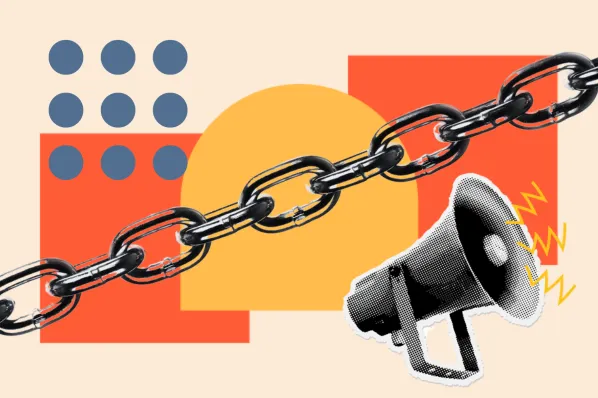Inbound links back to your website play an important role in achieving your inbound marketing goals. They also require strategy and diligent work to come by. I would know -- I worked very hard to earn inbound links for a long time.
Whether you're just starting out with inbound link building or you're getting fatigued by nobody replying to your outreach emails, I wanted to help you out. I've created nine different templates for killer outreach emails that you can borrow and adapt for your own link building strategy.
What Is Link Building?
Before we dive into the templates, let's quickly review the basics of inbound link building. If you're already caught up to speed, skip ahead to check out the templates.
Inbound links, otherwise known as backlinks, are links pointing toward your website from another website.
Here's an example: Check out this publishing volume experiment analysis on the Moz Blog. If you'll notice, the previous sentence contains a link pointing toward Moz's website. That's a backlink. And if you read the article, you'll notice it contains a link pointing back to our website here at HubSpot. That's a backlink, too.
Now that we all understand what inbound links are, why are they important?
- Inbound links drive traffic to your website. In the example above, the HubSpot blog earned traffic from any of Moz's blog readers who followed the link to HubSpot's website.
- Inbound links improve your search engine rankings. Inbound links tell search engines that your website knows what it's talking about -- otherwise, why would someone link to it? The more inbound links you earn from high-quality sites, the higher your website will rank in search engine results pages (SERP).
To sum up, inbound links are valuable because they help your website rank higher in search, which helps more people find your organization, start clicking around, and eventually become a lead.
Link building is the process of obtaining those inbound links. When your website is a high-powered, well-respected content engine, other sites and individuals online will link to your content organically -- without you having to ask. But if you're like a lot of other inbound marketers out there, your website still has a ways to go.
A dedicated link building strategy starts with an ask -- usually via email -- and that's where these templates come in.
Link Building Outreach Rules
But before we get to the templates, some rules.
There are right and wrong ways to go about improving your site's SEO, and inbound link building -- when done correctly -- is generally regarded as one of the right ways. You're pitching your content to publications that might be interested in sharing it with different audiences. A backlink is just the cherry on top.
However, there are wrong ways to go about asking for inbound backlinks, and I want to make sure you sure understand the rules of the road before you start emailing.
1) The best way to generate quality backlinks is to publish exceptional content publishers organically cite.
That being said, a dedicated backlink outreach strategy can be helpful for newer websites or if you're promoting a specific piece of exceptional content. The more content you produce and, in turn, promote with social media content and backlinks, the more search engine authority your site will accumulate.
2) Only pitch guest posts or backlinks that add value for the reader.
Instead of asking your contacts to randomly link back to your site somewhere on theirs, ask publishers if you can write for their blogs or conribute new ideas and data for content they're already working on. Offers such as these will result in quality backlinks that provide readers with valuable information.
3) Send individualized emails to specific publishers.
Never, and I mean never, mass email an enormous contacts list with a pitch template. It's spammy, impersonal, and likely won't get you the results you want anyway. Adapt the templates below if you like them, but it's critically important to individually craft specific emails for particular publishers.
The first step of your outreach process should always be researching publications and specific people who might be interested in your content. You shouldn't start with typing up an email and sending it to everyone in your industry with a website. Read on for new ideas for how to ask for an inbound link -- in ways that are polite, clever, and might just get you that backlink.
Note: These email templates are based on emails I've sent and received. Any references to industries, companies, or individuals are meant to illustrate these fictitious email examples.
9 Link Building Outreach Email Examples to Try
1) The preview
If you don't have any connections with the person you're pitching, offering a preview might be an effective way to share your content. With this type of email, you're asking first if the recipient would like to see the piece of content you'd like them to link to. The key to getting a reply is making sure you've personalized your email and enticed the reader with enough details to get them to reach back out.
Hi Sophia,
Happy Friday! I'm reaching out because I'm an avid reader of your work on the SocialVille blog -- I loved your latest piece about social media news.
I just followed you on Twitter, and I saw you've been tweeting about Facebook's F8 conference. What did you think of the event?
I work over at SocialWorld, where we conduct market research and collect data for social media analysts and experts. We recently produced an infographic detailing a breakdown of the social media market and what changes you can expect over the next year.
Would you be interested in checking it out? I'd love to see what you think.
Let me know if you're interested, and I can send you the infographic to take a look.
Best, Jack
2) The exclusive offer
If you've produced new research or data with surprising or intriguing results, it might be worth pitching your content as an exclusive before pressing publish on your own blog. An exclusive offer to a top-ranking publication in your industry could get you a lot of traffic from a single link, so it might be worth adjusting or reconsidering your own publication schedule.
When pitching to top journalists whose inboxes are probably flooded, keep your subject lines detailed and your emails short to communicate as much information in as few words as possible.
Hey Sophia,
I've been reading your coverage of the competition heating up between Snapchat and Instagram, and I wanted to let you know that we're releasing new data about Snapchat ad usage this week.
Among other insights, we found a surprising number of brands and publishers that were regularly advertising and publishing on Snapchat have started transitioning over to Instagram, where they achieve higher ad clickthrough rates.
I'd be happy to give you exclusive early access to our full report to be the first to write about it on the blog this week -- what do you think?
Best, Jack
3) The DYK
Everyone likes to learn a fun fact. Couch your pitch as a "did you know" moment to pique the recipient's curiosity to read the rest of your content for more fun and new information. If you were able to teach them something new, they may want to feature your fresh insight for their own readers.
Hi Sophia,
Did you know that there are more than 100,000 active bots on Facebook Messenger?
If you aren't already communicating with your audience via Facebook Messenger, you could be missing out on an opportunity to provide better customer service -- and faster.
We rounded up more Messenger bot usage stats in a new report that I've attached below. Do you think it would be a good fit for an article on the SocialVille blog? Thanks in advance for checking it out, and let me know if you have any questions.
Best, Jack
4) The personalized pitch
The most critical part of a successful outreach email is personalization. I'm not talking about addressing your email to the correct name and spelling everything correctly -- although you should definitely do both of those things. By showing the recipient that you know who they are and what they're about, your pitch reads as genuine, and you read as a comprehensive possible partner.
It's easy to write, "I loved your last article about [subject]," but it takes some digging and understanding to write, "I love reading your monthly social media news series. Did you catch the latest Facebook update that came out today?" Make sure your email shows that you've taken the time to understand what the person is all about and what they regularly cover.
Hi Sophia,
I know you've been closely following the social media smackdown between Snap Inc. and Facebook -- and I know who we're both rooting for. So I wanted to show you this interactive timeline we created that compares the growth trajectories of the two companies.
Snap Inc. is similar to Facebook in a lot of ways, but its path to growth into the billions is mired with more competition. But this competition hasn't limited Snapchat's engagement -- users are spending up to half an hour a day inside the app.
I noticed that you publish a social media news roundup every month featuring the latest stories and research, and I wondered if you thought this timeline could be a good inclusion. Let me know if you have any questions about the data!
Thanks, Jack
5) The offer
Nobody likes having extra work on their plate, so why not pitch doing the work for them? If you pitch a great idea alongside an offer to write a guest post, the recipient might be more inclined to say "yes." But remember to do your due diligence before pressing "send." If the person you're pitching has already written about a specific angle a few times before, make sure you're pitching something new and different to avoid getting ignored.
Hey Sophia,
You've written previously about successful Facebook ads and headlines, and I wanted to share some new research my team has put together about effective Facebook ad copy. We found that Facebook ads under 20 words in length performed significantly better than longer ads, along with a ton of other eye-opening stats.
Do you think this would be a good fit for the SocialVille blog? I'd be happy to write it up for you to take the legwork out of it. Let me know if you'd like me to get started.
Thanks for your consideration, Jack
6) The mention
Everybody likes to see their name in print. A clever way to angle for a backlink is to mention a product or an individual in a published piece, then circle back and share it with them. Ask for their feedback to get them reading the post, and they might link to it or share it on social of their own accord.
Hey Sophia,
I love reading your stuff on the SocialVille blog! In fact, we featured your recent data about the impact of tools on productivity in our report on the growth of productivity as a business -- I've attached the PDF below, and we've also shared it on Twitter.
I wonder if you'd be able to check out the report and let me know what you think or if I missed any important stats.
Thanks in advance for checking it out, and thanks for such an interesting write-up.
Best, Jack
7) The social proof
Social proof is the concept that consumers will be influenced by what others are already doing. For example, if you head to the bottom of this blog post, you'll notice that we ask you to subscribe, noting that 300,000 marketers have already subscribed. That's social proof in action: You might be more likely to subscribe now that you know hundreds of thousands of people are already doing it.
So, if you've published a great piece of content that people are responding positively to, tell people that when you pitch it for backlinks. They might be more inclined to cite you if other people in their field are already doing so.
Hi Sophia,
I'm sure you get a lot of content submissions, but I wanted to bring to your attention to a new guide we released about the ins and outs of Instagram ad advertising.
This helpful how-to guide tells you everything you need to know about advertising on Instagram and how to drive ROI, in addition to sharing real-world examples of ads that delivered results. Shameless #humblebrag here -- the guide has been downloaded more than 5K times and has been retweeted more than 4K times -- so I wanted to make sure you had a chance to check it out.
Do you think it would be a good fit for the SocialVille blog? I'd love to get your thoughts.
Best, Jack
8) The joke
Tread carefully with humor, but if you've perused their social media and they seem like they would appreciate a goofy joke, it could be a smart way to get your recipient's attention.
As in the rules of the workplace or cocktail parties, avoid making jokes about politics, religion, or anything rated PG-13 and up.
... they all went viral on social media!
Forgive the silly joke, but I knew cats would get your attention. I loved your recent piece about social media predictions for the coming year, and I wondered if you'd given any thought to predictions for where SEO is headed, too.
Here at SearchWorld, we predict that AMP and machine-learning will take center stage in Google's quest to make search easier and more intuitive for the searcher.
We put together a report about how SEO has evolved and other predictions for where we think it's headed next, and I think it would be a great reference if you decide to write a follow-up piece about the future of SEO. I've attached the report below -- take a look, and let me know if there are any changes you'd suggest!
Thanks in advance, Jack
9) The response
This is another risky outreach strategy, but it could pay off if you do it properly.
The ultimate way to demonstrate that you're an avid reader (instead of just saying so) is to respond to someone's work with an opinion -- even if it's divergent. Other options besides the counterpoint in the example below could include:
- A case study of you taking their advice and applying it to your brand
- A different content format on the same subject -- for example, a video explainer instead of a blog post
Hey Sophia,
Thanks for writing such a thorough recap of Facebook's F8 conference. It was super helpful for those of us who couldn't attend in person or watch the live stream!
I thought you made an interesting point about the competition heating up between Facebook and Snap Inc., but I think you could be missing a bigger idea here. I think it's not as much a competition for users as it is a competition for features innovation vs. features execution.
I wrote up my take on the brands' competition on our blog today and cited your recap -- would you like to take a look? Maybe we could collaborate together on a blog post or video on how social media marketers should best evaluate the two companies' competing apps.
Thanks, Jack
Email Link Building Best Practices
So, you might have noticed that these aren't the traditional templates you can copy and paste into your own inbox.
And that's because I don't want you to simply plug in these emails and replace them with your own pitch. Part of the reason successful link building takes time and effort is because you have to craft a personalized email every time. You should use the guidelines I've outlined above, but copying and pasting the same exact message is just bad news for all involved. Don't do it.
Below are more of my link building outreach email best practices:
1) Edit, then edit again.
Nothing makes me less interested in responding to a pitch email than when there is immediately a typo or grammatical error as early as the subject line -- or my name. Double-check to ensure that all names are spelled correctly, that capitalization is perfect (Hubspot vs. HubSpot), and that punctuation is perfect.
On the other side of editing, cut your email down wherever you can. It's better for your email to be on the shorter side than too long, so try to delete any extra words and phrases that aren't completely necessary.
2) Keep your subject lines short and sweet.
My rule of thumb for subject lines is to avoid making them complete sentences. Stick to the important details to communicate as much enticing information in as few words as possible. If your brand name is recognizable, make sure to name drop yourself, too.
3) Don't fake flattery.
If it's easy to tell when someone's compliments are inauthentic in person, it's even easier to tell via email. Don't flatter people you're contacting for the sake of it -- genuinely compliment their work, their insights, or their achievements, and take the compliment a step further to add value with your own content.
4) Do the legwork before you send.
Demonstrate that you know what you're talking about by doing your research before you press "send." When you think you've found the right person to pitch, take some time to research what they've written about in the past and what they discuss on social media. Pay attention to timing, too. If an author has just written about social media statistics, they might not want to write about the same angle one week later, so try to bring a new or related pitch to the table.
5) Don't follow up more than once or twice.
Let's face it -- we're all busy. Even if your outreach email is impeccable, it could get lost in someone's inbox during a busy morning. You should feel free to reach out once to follow up, but don't go overboard in pestering someone if they're not getting back to you. After one or two follow-ups, let your pitch go, and reach out to them with another pitch further down the line.
For more link building strategies and best practices, the pros over at Moz can point you in the direction of more replies and backlinks and fewer ignores and "no"s. For more must-have SEO strategies to tackle in 2017, check out our free guide here.
Do you have an email link building outreach email that got you great results? Share with us in the comments below.
Link Building




.jpg)







![How to Find & Add Nofollow Links to Your Website [Step by Step]](https://53.fs1.hubspotusercontent-na1.net/hubfs/53/how-to-add-nofollow-links.jpg)